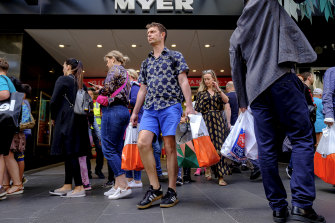Confidence among inflation-shocked shoppers has collapsed this year as fast as during the depths of the pandemic and the advent of the global financial crisis, but consumers are still not winding back their spending.
As one of the nation’s largest lenders said the Reserve Bank would speed up the pace of monetary policy tightening, key measures of consumer sentiment showed the extent of the impact inflation and recent interest rate increases are having on shopper confidence.
While consumer confidence has dropped people have continued to spend, new data shows.Credit:Luis Ascui
Westpac’s monthly measure of sentiment slipped another 3 per cent in July, its seventh consecutive monthly drop.
It is now 19.7 per cent down on where it was in December, a fall similar to the 20.8 per cent drop in the early stages of the pandemic, the 20.5 per cent fall in the early 1990s recession and worse than the easing in the early 1980s recession (18.8 per cent).
Three in five respondents to the survey recalled news about inflation in a clear sign the lift in prices, from petrol to lettuce, is high in the mind of shoppers.
The ANZ-Morgan weekly measure of consumer sentiment fell 2.5 per cent over the past seven days and is now back where it was in the early stages of COVID.
Senior ANZ economist Felicity Emmett said last week’s 0.5 percentage point lift in official interest rates had weighed on sentiment.
She said confidence among mortgage holders fell by 5.4 per cent last week, with an even bigger hit since the RBA started lifting rates in May.
“This continues the trend in place since late April when the high March quarter inflation report brought forward rate hike expectations,” she said.
“Since then, confidence amongst mortgage holders has fallen 25 per cent, while confidence for renters is down just 4 per cent. Inflation expectations lifted as petrol prices hover near record highs.”
While confidence is down, shoppers’ wallets are still open.
The Commonwealth Bank’s household spending intentions index rose by 0.9 per cent in June to be 11.9 per cent up over the past year.
The bank’s chief economist, Stephen Halmarick, said some of the increase was driven by the lift in prices now being endured by consumers.
“The index’s modest gain in June was narrowly based, driven mainly by the increased price of many goods and services, such as petrol, which helped drive higher spending on transport, along with increased spending on education and household services,” he said.
Halmarick said interest rate-sensitive areas of the economy were now clearly showing the effect of Reserve Bank interest rate hikes.
Intentions around home buying dropped, as did intentions for discretionary spending on entertainment and retail.
“With further interest rate increases expected through the remainder of 2022, we would expect to see discretionary spending weaken further in coming months,” he said.
A separate measure of household spending from the Australian Bureau of Statistics showed a further increase through May. Spending on discretionary goods, the most affected by interest rate rises, has climbed by 8.9 per cent over the past 12 months compared to a 6.9 per cent increase in non-discretionary products.
The Reserve Bank started lifting interest rates in May, taking them to 1.35 per cent from 0.1 per cent. Markets expect the bank to increase them by another 0.5 percentage points at its next meeting in August.
NAB’s economics team now believes the RBA will have the official cash rate at 2.35 per cent by November and then 2.6 per cent by the middle of next year.
It said by then, consumer spending should be slowing and inflation pressures starting to ease. But there are risks given the amount of debt held by home buyers due to the surge in property prices through the pandemic.
“While households have built up a large buffer of saving during the pandemic consumer confidence has already fallen sharply and the speed at which rates have risen may provide an additional challenge,” they said.
Cut through the noise of federal politics with news, views and expert analysis from Jacqueline Maley. Subscribers can sign up to our weekly Inside Politics newsletter here.
Most Viewed in Politics
From our partners
Source: Read Full Article
